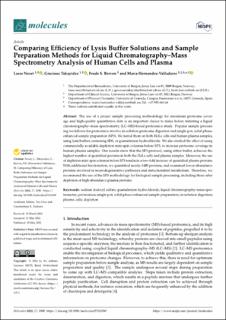| dc.contributor.author | Neset, Lasse | |
| dc.contributor.author | Takayidza, Gracious | |
| dc.contributor.author | Berven, Frode Steingrimsen | |
| dc.contributor.author | Hernandez-Valladares, Maria | |
| dc.date.accessioned | 2022-09-16T11:20:07Z | |
| dc.date.available | 2022-09-16T11:20:07Z | |
| dc.date.created | 2022-09-12T16:09:36Z | |
| dc.date.issued | 2022 | |
| dc.identifier.issn | 1420-3049 | |
| dc.identifier.uri | https://hdl.handle.net/11250/3018442 | |
| dc.description.abstract | The use of a proper sample processing methodology for maximum proteome coverage and high-quality quantitative data is an important choice to make before initiating a liquid chromatography–mass spectrometry (LC–MS)-based proteomics study. Popular sample processing workflows for proteomics involve in-solution proteome digestion and single-pot, solid-phase-enhanced sample preparation (SP3). We tested them on both HeLa cells and human plasma samples, using lysis buffers containing SDS, or guanidinium hydrochloride. We also studied the effect of using commercially available depletion mini spin columns before SP3, to increase proteome coverage in human plasma samples. Our results show that the SP3 protocol, using either buffer, achieves the highest number of quantified proteins in both the HeLa cells and plasma samples. Moreover, the use of depletion mini spin columns before SP3 results in a two-fold increase of quantified plasma proteins. With additional fractionation, we quantified nearly 1400 proteins, and examined lower-abundance proteins involved in neurodegenerative pathways and mitochondrial metabolism. Therefore, we recommend the use of the SP3 methodology for biological sample processing, including those after depletion of high-abundance plasma proteins. | en_US |
| dc.language.iso | eng | en_US |
| dc.publisher | MDPI | en_US |
| dc.rights | Navngivelse 4.0 Internasjonal | * |
| dc.rights.uri | http://creativecommons.org/licenses/by/4.0/deed.no | * |
| dc.title | Comparing Efficiency of Lysis Buffer Solutions and Sample Preparation Methods for Liquid Chromatography–Mass Spectrometry Analysis of Human Cells and Plasma | en_US |
| dc.type | Journal article | en_US |
| dc.type | Peer reviewed | en_US |
| dc.description.version | publishedVersion | en_US |
| dc.rights.holder | Copyright 2022 by the authors | en_US |
| dc.source.articlenumber | 3390 | en_US |
| cristin.ispublished | true | |
| cristin.fulltext | original | |
| cristin.qualitycode | 1 | |
| dc.identifier.doi | 10.3390/molecules27113390 | |
| dc.identifier.cristin | 2050940 | |
| dc.source.journal | Molecules | en_US |
| dc.identifier.citation | Molecules. 2022, 27 (11), 3390. | en_US |
| dc.source.volume | 27 | en_US |
| dc.source.issue | 11 | en_US |

